TRUCKIN’ (THE INDIAN-APOLIS 500)
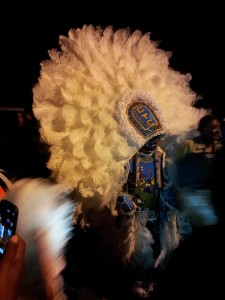 My heart raced with excitement as I shot down the narrow, rugged side streets of Uptown. Thinking my roommate had spotted a lone tribe of wandering Mardi Gras Indians, I was afraid of missing my chance.
My heart raced with excitement as I shot down the narrow, rugged side streets of Uptown. Thinking my roommate had spotted a lone tribe of wandering Mardi Gras Indians, I was afraid of missing my chance.
As I approached 4th Avenue, there were already cars lining the sides of the road. I pulled onto an overgrown grass shoulder in between two large aboveground cemeteries of typical New Orleans style. The moon shining off the bone-white tombs amplified the mystical aura of electricity filling St. Joseph’s Night, and up ahead I caught glimpses of bright beads and feathers rising above the growing crowd that was snapping photos and cheering on the dancing explosions of walking art.
THE FINE LINE BETWEEN CONFRONTATION & COOPERATION
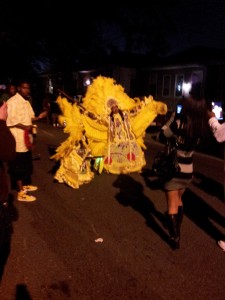 As I rushed down the road, I thrilled to see the vibrant costumes materialize in bright blues, oranges, yellows, and purples, all glowing fantastically under misty streetlights and inside bursts of brilliance from frantically flashing cameras. The marchers were chanting, bobbing up and down, and spinning in circles as revelers cheered them on. Marchers kept the rhythm with clapping and tambourines while a small drum line followed to augment the beat.
As I rushed down the road, I thrilled to see the vibrant costumes materialize in bright blues, oranges, yellows, and purples, all glowing fantastically under misty streetlights and inside bursts of brilliance from frantically flashing cameras. The marchers were chanting, bobbing up and down, and spinning in circles as revelers cheered them on. Marchers kept the rhythm with clapping and tambourines while a small drum line followed to augment the beat.
The procession was actually going down Washington Avenue, and as two resplendently masked Indians made their way through an intersection, two maskers ahead of them dressed identically as bulls turned around and rushed back, swerving at the crowd and causing onlookers to jump back with a gasp. As the bulls approached the Chief and his lieutenants I couldn’t tell if they were confronting them or trying to communicate.
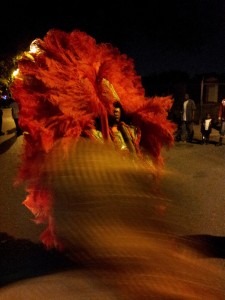 Part of the beauty of Mardi Gras Indian culture is its mystery. You don’t know where they’re going, when they’re going there, and what they’re saying along the way. Thus I wasn’t sure whether I was witnessing mock confrontation or cooperation. Were these advance scouts reporting back or tails from the tribe ahead warning them to keep their distance? One thing was clear, though: My haste was unnecessary. This wasn’t a random wandering tribe but well over a dozen groups marching in procession from both Uptown and Downtown, perhaps every tribe in the city. I had trouble discerning where one tribe ended and another began.
Part of the beauty of Mardi Gras Indian culture is its mystery. You don’t know where they’re going, when they’re going there, and what they’re saying along the way. Thus I wasn’t sure whether I was witnessing mock confrontation or cooperation. Were these advance scouts reporting back or tails from the tribe ahead warning them to keep their distance? One thing was clear, though: My haste was unnecessary. This wasn’t a random wandering tribe but well over a dozen groups marching in procession from both Uptown and Downtown, perhaps every tribe in the city. I had trouble discerning where one tribe ended and another began.
A WHOLE LOT OF EBONY, A LITTLE BIT OF IVORY
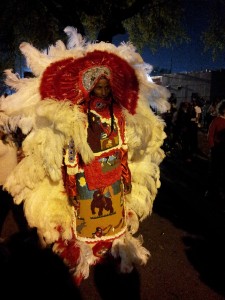 There is no set schedule to where the Indians will be, but word-of-mouth spreads quickly and a crowd always appears. I was fortunate to be in the loop that night, one of only a handful of Caucasians in the crowd (though this number grew as the night progressed). I say this not because I was uncomfortable, but curious. The white folks who were there were thrilled to be and accepted into the ritual, so I wondered why there were so few. Later that night and the next day as I excitedly told my story, most of the people I talked to seemed nonplussed. I say this only as observation and will leave it to sociologists to sort out once this blog is a media sensation.
There is no set schedule to where the Indians will be, but word-of-mouth spreads quickly and a crowd always appears. I was fortunate to be in the loop that night, one of only a handful of Caucasians in the crowd (though this number grew as the night progressed). I say this not because I was uncomfortable, but curious. The white folks who were there were thrilled to be and accepted into the ritual, so I wondered why there were so few. Later that night and the next day as I excitedly told my story, most of the people I talked to seemed nonplussed. I say this only as observation and will leave it to sociologists to sort out once this blog is a media sensation.
CHASING STREETLIGHTS & STEALING OTHER PEOPLE’S FLASHES
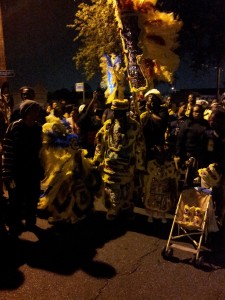 I had been embarrassed to admit to my Seattle friends that I’d not attended Super Sunday, missing a prime photo opportunity, so was eager to make up for it St. Joseph’s Night. As luck would have it, though, my camera battery had died on St. Patrick’s Day and I’d forgotten to pack my charger. No worries–I had my phone. Except I’d been texting all day with my would-be flake of a roommate and it was near dead too. Doh!
I had been embarrassed to admit to my Seattle friends that I’d not attended Super Sunday, missing a prime photo opportunity, so was eager to make up for it St. Joseph’s Night. As luck would have it, though, my camera battery had died on St. Patrick’s Day and I’d forgotten to pack my charger. No worries–I had my phone. Except I’d been texting all day with my would-be flake of a roommate and it was near dead too. Doh!
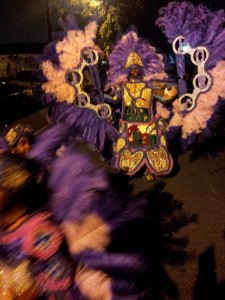 As I pushed into the crowd, I eagerly snapped a few shots before videoing the undulating procession. Although this burned up my precious battery, the above footage captures the rhythm, color, and movement, so was well worth the sacrifice. After a few attempts, though, my battery was too drained to operate a flash. I soon learned to wait until my subjects were under a streetlight or to time my shots with those of persons beside me with working flashes to take advantage of the light. It was a crash course on minimalist photojournalism!
As I pushed into the crowd, I eagerly snapped a few shots before videoing the undulating procession. Although this burned up my precious battery, the above footage captures the rhythm, color, and movement, so was well worth the sacrifice. After a few attempts, though, my battery was too drained to operate a flash. I soon learned to wait until my subjects were under a streetlight or to time my shots with those of persons beside me with working flashes to take advantage of the light. It was a crash course on minimalist photojournalism!
During a break in the action I ran back to my truck and started the engine, trying to funnel precious juice into my phone. Standing up in the open door, I watched the action from afar while passers-by looked at me curiously. When another wave of waving color arrived, I dashed back down the road.
TWO LITTLE INDIANS: TRADITION IN TRANSITION
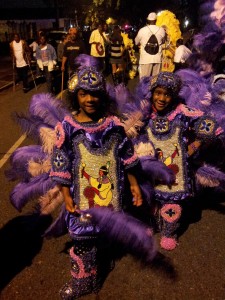 Indian culture is now largely considered a positive influence on impoverished neighborhoods, acting as mutual aid societies to support neighbors in need and as a way to constructively channel energy—‘idle hands’ theology in action. Thus the most stirring site was children in elaborate costumes marching alongside their parents as a living embodiment of tradition passing between generations. Two little girls in purple were particularly proud to pose, beaming when I called them pretty.
Indian culture is now largely considered a positive influence on impoverished neighborhoods, acting as mutual aid societies to support neighbors in need and as a way to constructively channel energy—‘idle hands’ theology in action. Thus the most stirring site was children in elaborate costumes marching alongside their parents as a living embodiment of tradition passing between generations. Two little girls in purple were particularly proud to pose, beaming when I called them pretty.
ABSOLUTELY MAYBE, BUT MOST DEFINITELY NOT
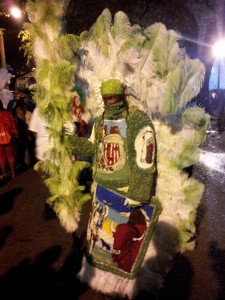 As I made my way up the road and against the tide, I bought beer from an enterprising citizen with a cooler in the hatch of his SUV. Such backseat entrepreneurs were everywhere, obviously prepared in advance. Just like the crowds lining the streets, vendors dotted the crowd to complete the carnival atmosphere, ranging from amateurs grilling beside their vehicles to fully functional food trucks strategically parked in prime locations.
As I made my way up the road and against the tide, I bought beer from an enterprising citizen with a cooler in the hatch of his SUV. Such backseat entrepreneurs were everywhere, obviously prepared in advance. Just like the crowds lining the streets, vendors dotted the crowd to complete the carnival atmosphere, ranging from amateurs grilling beside their vehicles to fully functional food trucks strategically parked in prime locations.
It was my understanding that the Indians didn’t announce their route, yet three different vendors claimed that a parade route was on file with the city, although none could quite articulate a coherent explanation. To clarify I approached three different police officers, none of whom was happy to be bothered, and all three independently affirmed that they had no idea where the Indians were going to march. Having heard that the police viewed these impromptu parades as a bother, I encountered nothing here to contradict that understanding. All three officers seemed chagrined at having to rush to the scene to keep the peace.
Like everything else about the Indians, their plans remained a mystery. Was it pre-planned or spontaneous? My best guess is that vendors and certain key community members were given advanced notice but not the cops.
I also inquired around as to why the Indians marched on St. Joseph’s Night but no one seemed to know. One cynical theory shared was that since everyone gathers on St. Joseph’s Night the Indians saw it as prime opportunity to usurp attention. Elsewhere I encountered the more generous theory that when Sicilians arrived in New Orleans after emancipation, they worked alongside freed blacks in fields unlike other settlers, so the Indians felt a sense of connection with them and their sacred day, much as they mask as Indians to honor the tribes that sheltered runaway slaves. This was all conjecture, though, but stay tuned as I try to arrange an interview with a Chief to learn the truth.
PROUD, BUT NOT A PEACOCK
I spent over two hours running up and down Washington Avenue in a state of wonder, nursing my phone until it finally gave up the ghost. Seeing Mardi Gras Indians during the day is amazing, but beholding them at night is mystical and magical in a way that must be observed to be understood.
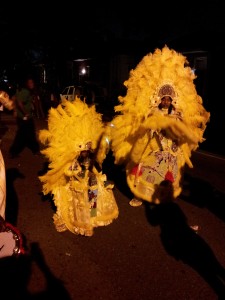 It would seem almost inevitable for grown men in hand-sewn costumes of bead and feather prancing about like Peacocks chanting in super-secret languages to appear childish and effeminate. Yet Mardi Gras Indians are neither. Their pride, defiance, and splendor transcends preening or childishness, though I would guess (with strong conviction) that this defiance and posturing is what turns off many New Orleanians as arrogant or intimidating; however, viewed through a lens of historical and sociological sensitivity it is a majestic display of strength and resiliency.
It would seem almost inevitable for grown men in hand-sewn costumes of bead and feather prancing about like Peacocks chanting in super-secret languages to appear childish and effeminate. Yet Mardi Gras Indians are neither. Their pride, defiance, and splendor transcends preening or childishness, though I would guess (with strong conviction) that this defiance and posturing is what turns off many New Orleanians as arrogant or intimidating; however, viewed through a lens of historical and sociological sensitivity it is a majestic display of strength and resiliency.
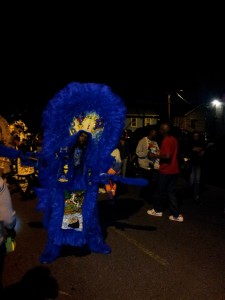 The essence of New Orleans radiates from its communal commitment to celebrating the everyday and making meaning from chaos. Historically, life here was stark and brutal even for the well-off, yet while a city of riches and splendor, it is also a city of crushing poverty where the intangible barrier between the haves and have-nots is vast yet the physical distance practically non-existent—it’s not uncommon to have million dollar mansions a block or two from imploding projects. Rather than capitulate to scarcity of resources, though, even New Orleans’s poorest citizens construct joy and meaning, displaying their pride and creativity through art, music, cuisine, and, most uniquely, elaborate Indian costumes.
The essence of New Orleans radiates from its communal commitment to celebrating the everyday and making meaning from chaos. Historically, life here was stark and brutal even for the well-off, yet while a city of riches and splendor, it is also a city of crushing poverty where the intangible barrier between the haves and have-nots is vast yet the physical distance practically non-existent—it’s not uncommon to have million dollar mansions a block or two from imploding projects. Rather than capitulate to scarcity of resources, though, even New Orleans’s poorest citizens construct joy and meaning, displaying their pride and creativity through art, music, cuisine, and, most uniquely, elaborate Indian costumes.
THE TEEN AWKWARDNESS OF A TUBA & TWO TROMBONES
Returning to my truck tucked away between bone-white sentries, I felt content knowing I’d witnessed something truly unique and vital. I drove down a few side streets trying to catch up with the procession but they had disappeared into the night as magically as they appeared.
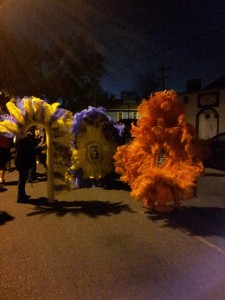 Yet before I returned to my truck I had witnessed one last moment illustrating the charming singularity of this city. Once at Jazzfest Ellis Marsalis paused at his piano to comment that while in other cities culture trickles down from the top, in New Orleans it rises up from the street, referring to a culture compulsion that nurtures young musicians. Unlike anywhere else, in New Orleans the ultimate way for kids to strut and prove their prowess is on a horn or drum, as likely to be caught practicing with a budding jazz quintet as shut inside playing X-box.
Yet before I returned to my truck I had witnessed one last moment illustrating the charming singularity of this city. Once at Jazzfest Ellis Marsalis paused at his piano to comment that while in other cities culture trickles down from the top, in New Orleans it rises up from the street, referring to a culture compulsion that nurtures young musicians. Unlike anywhere else, in New Orleans the ultimate way for kids to strut and prove their prowess is on a horn or drum, as likely to be caught practicing with a budding jazz quintet as shut inside playing X-box.
Thus I enjoyed a hearty laughed as I passed a group of kids jawing back and forth as I walked to my truck. Although engaging in good natured trash-talk like you might observe on any urban corner, the content of the cut-downs were strictly New Orleans: “Man, you guys still be marching with nothing more than a tuba and two trombones!” The group fell out with laughter. Bazinga!
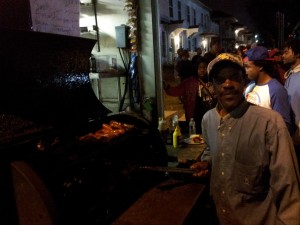
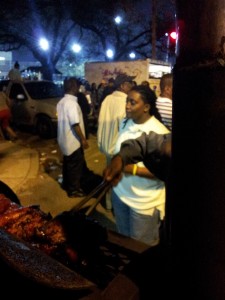
[…] PREVIOUS ARTICLE […]